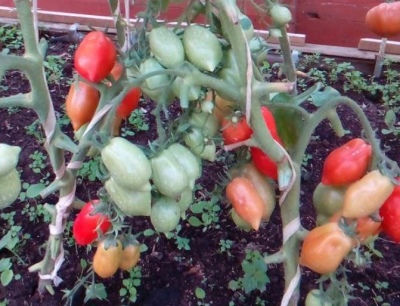
- Authors: LLC 'Agrofirma AELITA'
- Year of approval: 1967
- Category: grade
- Growth type: determinant
- Appointment: for whole fruit canning
- Ripening period: mid-early
- Ripening time, days: 104-130
- Growing conditions: for open ground
- Transportability: Yes
- Bush size: undersized
Tomato variety New from Transnistria is focused on both industrial cultivation and planting in personal subsidiary plots. Possesses excellent commercial properties, suitable for whole-fruit canning. Focused on outdoor cultivation.
Breeding history
The variety was registered in 1967, bred by breeders from Moldova. Included in the State Register. At the moment, Agrofirma Aelita LLC is indicated as the originator.
Description of the variety
The variety is determinate, undersized, even in a greenhouse it stretches no more than 40-80 cm. The tops are compact, not spreading, abundantly covered with large and medium-sized leaves. Growing may require thinning branches. The inflorescences are simple, they are laid above 6-7 leaves. When 5 brushes appear, growth stops.
The main qualities of the fruit
Tomatoes have a characteristic cylindrical shape. Ripe red, with dense pulp, unripe greenish-whitish fruits. The average weight varies between 35-56 g. The skin is smooth.
Taste characteristics
The fruits are successfully stored for up to 2 months. The taste is traditional, full-bodied, without excessive sweetness.
Ripening and fruiting
The average time for tomatoes to reach maturity is 104-130 days for this variety.
Yield
The high-yielding variety is actively cultivated on farms. Average collection rates are 409-948 kg / ha. Harvesting is possible in a mechanized way. The fruits are harvested from July to September.
The timing of planting seedlings and planting in the ground
Seeds for seedlings begin to be prepared in the 3rd decade of March, and sometimes they are sown in early April. It is not recommended to violate these terms. Otherwise, due to the short daylight hours, the shoots will be strongly stretched. In early June, young tomatoes are transplanted into open ground.

Growing tomato seedlings is an extremely important process, because it largely depends on whether the gardener can harvest at all. All aspects must be taken into account, from seedbed preparation to planting in the ground.
Landing scheme
Up to 4 bushes of the Novinka Pridnestrovie variety are placed on 1 m2. A distance of 50 × 40 cm is maintained between neighboring plants.

Growing and care
Bushes require pinching - to normalize the yield, adjust the ripening time. A well-lit place for tomatoes is chosen, the soil is disinfected in advance. You can increase the fertility of the soil by adding organic matter to it - compost, peat. The bushes are transferred to a new place after the appearance of the first flower brushes, having previously taken care of acclimatization. For transplanting, it is better to choose cool or cloudy weather.
Outdoor plants need moderate watering. It is held no more than 2 times a week. The rate of water consumption per bush is 2 liters.This variety is sensitive to the amount of phosphorus in the soil. When changing the color of the leaves to purple, you need to take care of the introduction of mineral dressing.




A plant needs different micronutrients at each stage of growth. All fertilizers can be divided into two groups: mineral and organic. Folk remedies are often used: iodine, yeast, bird droppings, eggshells.
It is important to observe the rate and period of feeding. This also applies to folk remedies and organic fertilizers.
Disease and pest resistance
Despite its good resistance to the main diseases of tomatoes, the variety is recommended to be subjected to preventive treatments for late blight and other infections. For this, a solution of copper sulfate is prepared at a concentration of 1 g per liter of water.


Growing regions
According to the recommendations of the originators, the variety is zoned for cultivation in the Middle Volga region, in the North Caucasus, in the Far East and in the Central Black Region without shelter.
Review overview
According to buyers, the tomato Novelty of Pridnestrovie embodies the classic version of plum tomatoes. The fruits are delicious and fresh, but are best suited for processing and canning. Seed buyers praise the good germination and the excellent vitality of the seedlings. The owners of personal plots also have no complaints about the yield. It is noted that during the harvest period, the bush is literally strewn with fruits.
Tomatoes can also be used in different ways. They are canned green and ripe, processed into sauces, put into salads. The fruits are strong, suitable for stuffing and freezing, and other culinary purposes. Summer residents notice that the bushes are not affected by late blight even when a disease is detected on other plants. The only drawback is the difficulty of buying seeds.

























































































